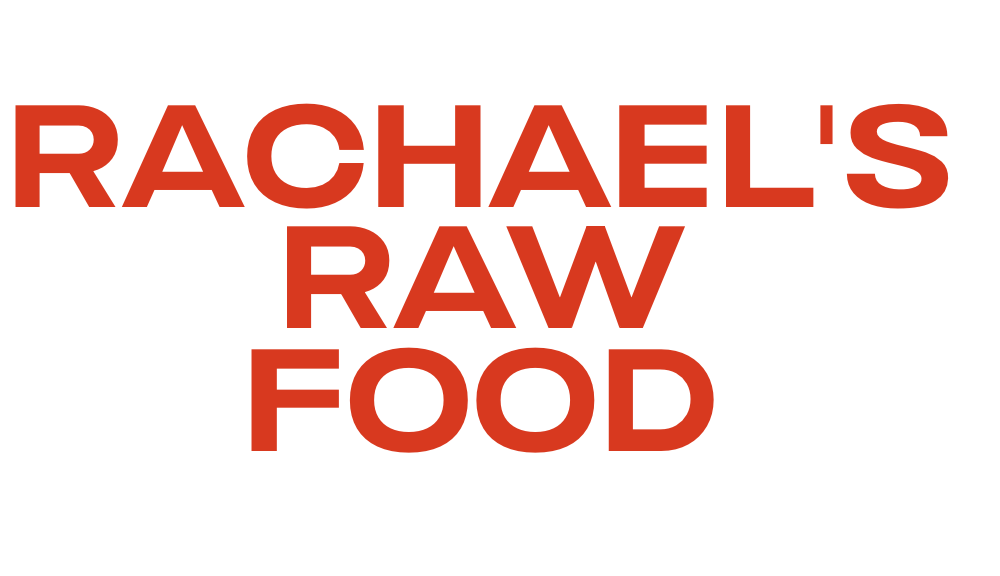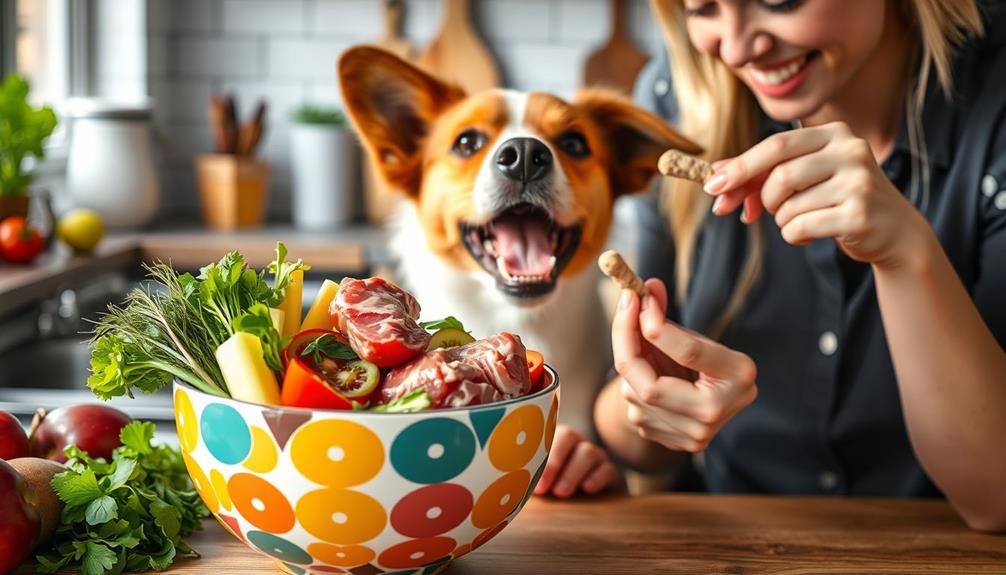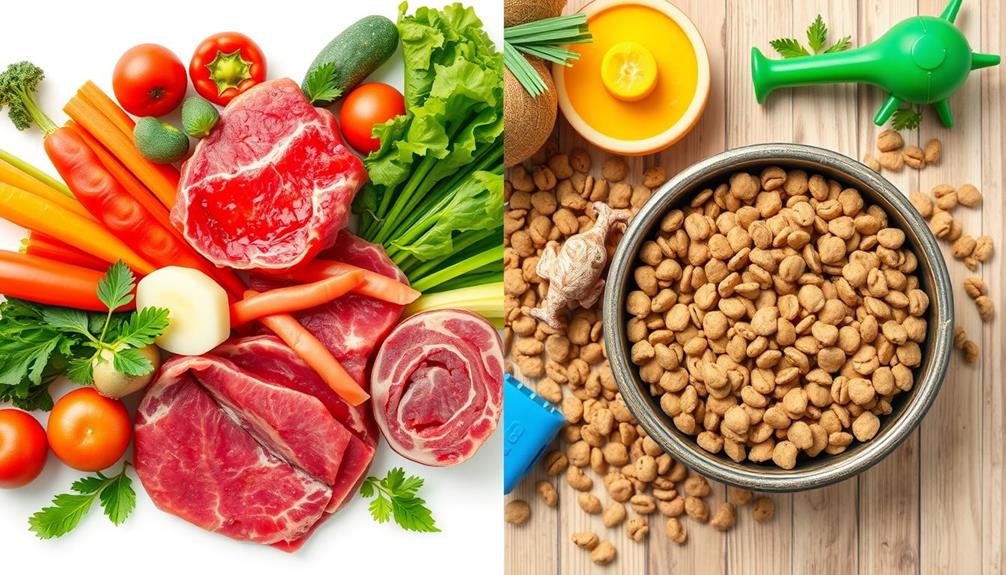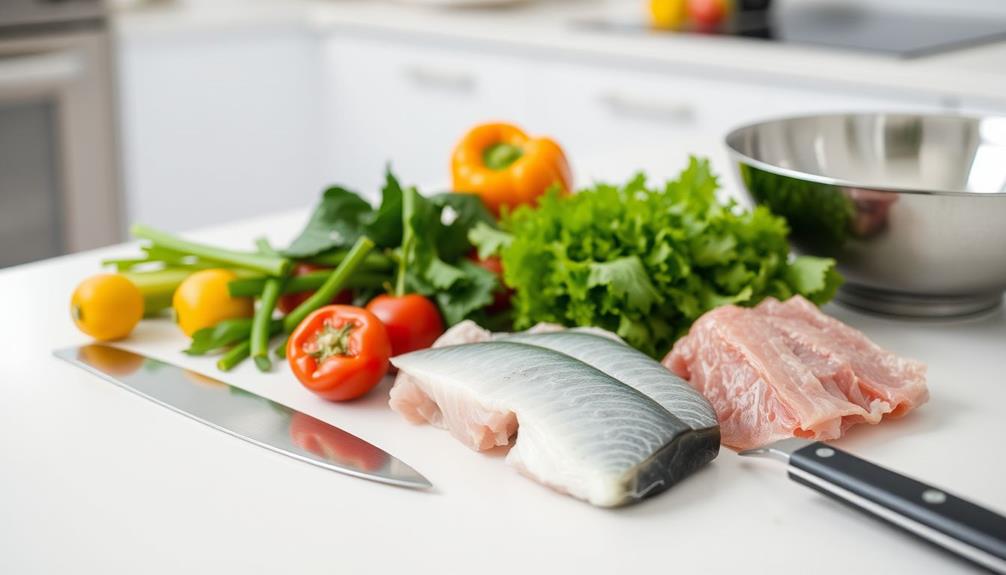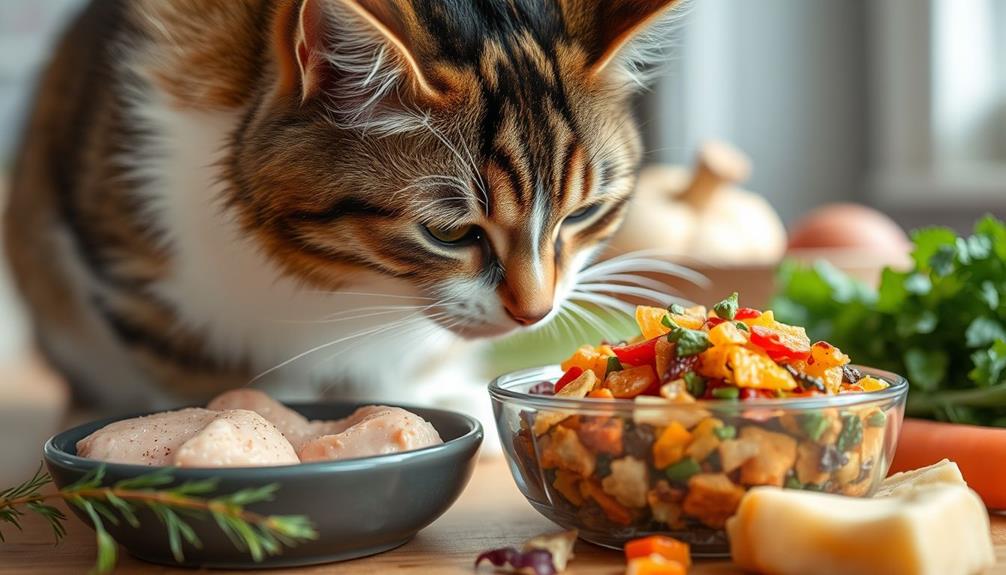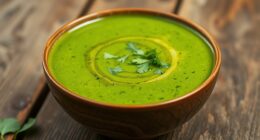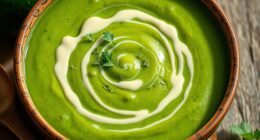Getting your dog to eat raw food can be simple with a few effective strategies. Start by gradually introducing raw food into their diet over about ten days, using a mix of kibble and raw to ease the shift. Enhance the food's appeal by warming it or adding different proteins, like chicken or beef. Create a calm feeding environment and establish consistent mealtimes. If your dog refuses to eat, stay neutral and avoid stress. Encourage exploration with interactive toys or food puzzles. Stick with it, and your pup will likely adapt. There's plenty more you can do to smooth the shift!
Key Takeaways
- Gradually transition your dog to raw food over 10 days, starting with a mix of 75% kibble and 25% raw food.
- Enhance the appeal of raw food by warming it slightly or adding aromatic oils to stimulate appetite.
- Introduce a variety of protein sources and rotate them to prevent boredom and encourage acceptance of raw food.
- Create a calm and designated feeding environment to help your dog feel relaxed and comfortable during mealtime.
- Monitor your dog's response to the new diet, adjusting portions and ingredients as needed for health and enjoyment.
Understand Raw Food Benefits
When it comes to your dog's diet, switching to raw food can bring a host of benefits that promote overall health. The raw food diet can greatly improve digestion and nutrient absorption, similar to the way a proper diet benefits small animals like hamsters.
You'll notice your dog thriving with better energy and a more active lifestyle. One of the standout benefits of raw feeding is the positive impact on skin and coat health. The natural oils found in these foods can lead to healthier skin and shinier coats, often alleviating skin allergies. Additionally, incorporating a variety of fresh fruits and vegetables can further enhance your dog's diet, just as safe snacks are important for hamsters in terms of health benefits.
Moreover, a raw diet can enhance your dog's immune system function, potentially reducing allergies and food sensitivities. You'll likely see your furry friend feeling more energetic and playful as a result.
Another essential benefit is dental health; the natural chewing action required for raw food helps maintain cleaner teeth and healthier gums, minimizing dental issues over time.
Gradual Transition Process
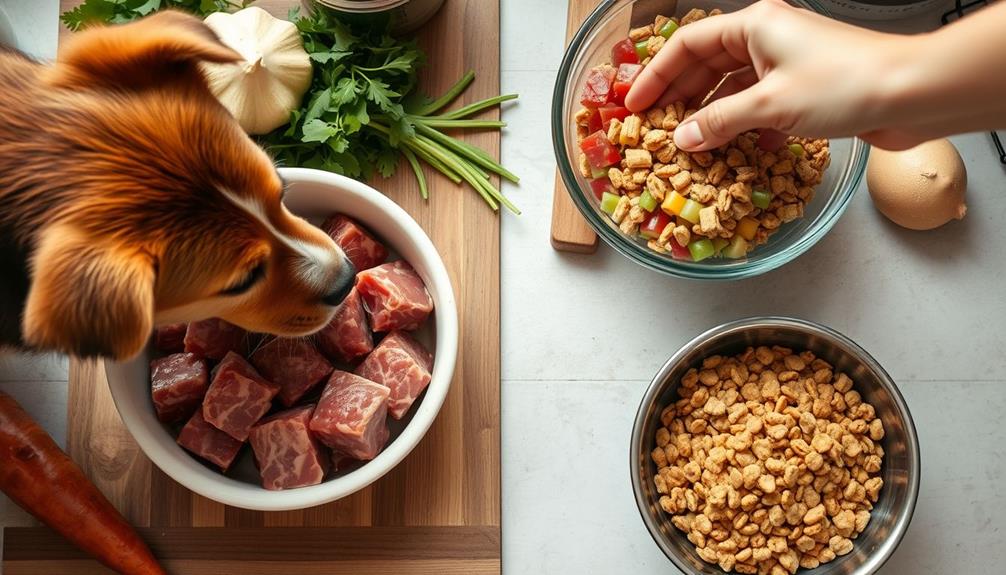
To smoothly shift your dog to a raw food diet, follow a clear timeline over ten days.
Start with a blend of 75% kibble and 25% raw, gradually moving to 100% raw by day ten.
It's vital to monitor your dog's health and behavior during this shift, as dietary changes can impact their overall well-being.
Additionally, consider the nutritional balance of the raw food you're introducing, as proper nutrition is important for your dog's health, similar to recommendations for cold medications that guarantee effective relief.
Don't forget to monitor your dog's reactions throughout this process, making adjustments as needed to guarantee their comfort and acceptance.
Transition Timeline Overview
A successful change to a raw food diet for your dog typically unfolds over a 10-day period, ensuring a gradual alteration that minimizes digestive issues.
Start the shift timeline by feeding your dog 75% kibble and 25% raw food for the first three days. This gradual introduction is vital, as it allows your dog's digestive system to adapt to the new diet without overwhelming it.
Incorporating healthy dog snacks can help maintain your dog's interest in the new food, making the shift smoother. Additionally, monitoring your dog's response to the new diet is important for identifying any potential sensitivities.
From days four to six, adjust the ratio to 50% raw and 50% kibble. This balance helps your dog become more accustomed to raw food.
Monitor Dog's Response
Monitoring your dog's response during the shift to a raw food diet is key to securing their comfort and health. As you start moving to raw food, keep a close eye on how your dog reacts. It's important to incorporate gentle techniques to alleviate stress, much like how yoga can help with relaxation.
Here are three important factors to reflect on:
- Digestive Health: Watch for any signs of digestive distress, like vomiting or loose stools, which may indicate detox symptoms. This is common but should be monitored closely.
- Energy Levels: Note changes in your dog's energy. Do they seem more energetic or lethargic? This will help you assess how well they're adapting to their new diet.
- Overall Appearance: Keep track of changes in their coat, skin, and weight. A healthy dog should show improvements in these areas over time.
If you notice any concerning symptoms, adjust portion sizes based on your dog's weight and activity level.
Patience is essential; initial rejection of raw food is normal. Think about supporting their digestion with plain canned pumpkin or probiotics during this shift period.
Enhance Food Appeal
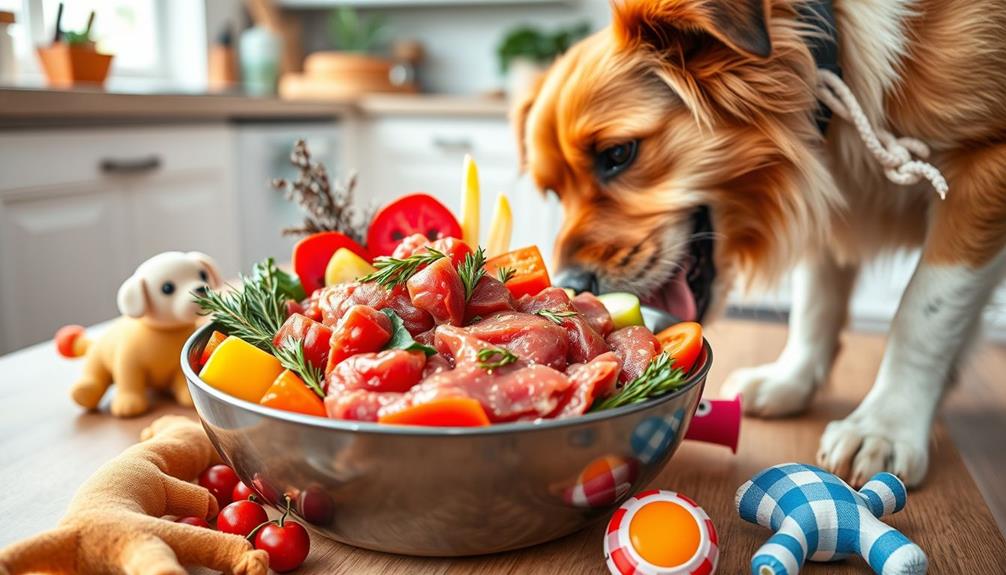
To make raw food more appealing to your dog, try warming it up slightly or serving it at room temperature to enhance its aroma.
Adding a few drops of essential oils for respiratory health like peppermint or eucalyptus can also help stimulate their appetite.
Experimenting with different protein sources like chicken or beef can also spark your dog's interest in raw meals.
Temperature Modification Techniques
Many dogs find warm food more appealing, so adjusting the temperature of raw meals can considerably enhance their interest. Just as various brewing methods can impact the flavor and aroma of coffee, understanding coffee culture can inspire you to create a more inviting mealtime for your pup.
Here are some effective temperature modification techniques to make raw food more enticing:
- Lightly Sear the Meat: A quick sear can enhance the aroma and flavor, making the raw food irresistible to your dog.
- Warm Broth: Mix raw food with warm broth or add hot water to elevate the temperature and appeal. This is especially helpful for dogs moving from kibble.
- Spoon-Feed: Try spoon-feeding raw food from a bowl. This personal touch can make the experience feel more inviting and encourage hesitant eaters.
Additionally, consider chopping and refreezing raw food patties into smaller pieces to mimic kibble texture, which can entice your dog further.
You can also stuff raw food into toys and freeze them, creating an engaging mealtime challenge that excites them about eating.
Protein Variety Exploration
After enhancing your dog's mealtime experience through temperature modifications, exploring protein variety can further boost their interest in raw food. Dogs might initially reject raw food simply because they're not familiar with the protein source. By introducing a mix of proteins like chicken, beef, lamb, and venison, you can help identify their preferences.
A varied diet can improve their overall health, promoting their well-being and vigor, similar to how antioxidants contribute to overall health benefits. We Feed Raw offers multiple protein options, making protein variety exploration easy and effective.
Persistence is key. Keep rotating different protein sources to prevent meal boredom and encourage your dog's willingness to try raw food. As you shift to a raw diet, remember that variety not only keeps mealtime interesting but also improves overall nutrition.
When dogs enjoy a diverse diet, they're more likely to embrace raw food, leading to better health outcomes.
Make it an adventure! Experiment with different flavors and textures, and observe what excites your dog the most. By prioritizing protein variety, you can make the shift to a raw diet enjoyable for both you and your furry friend, ultimately enhancing their mealtime experience and promoting a healthier lifestyle.
Explore Different Proteins
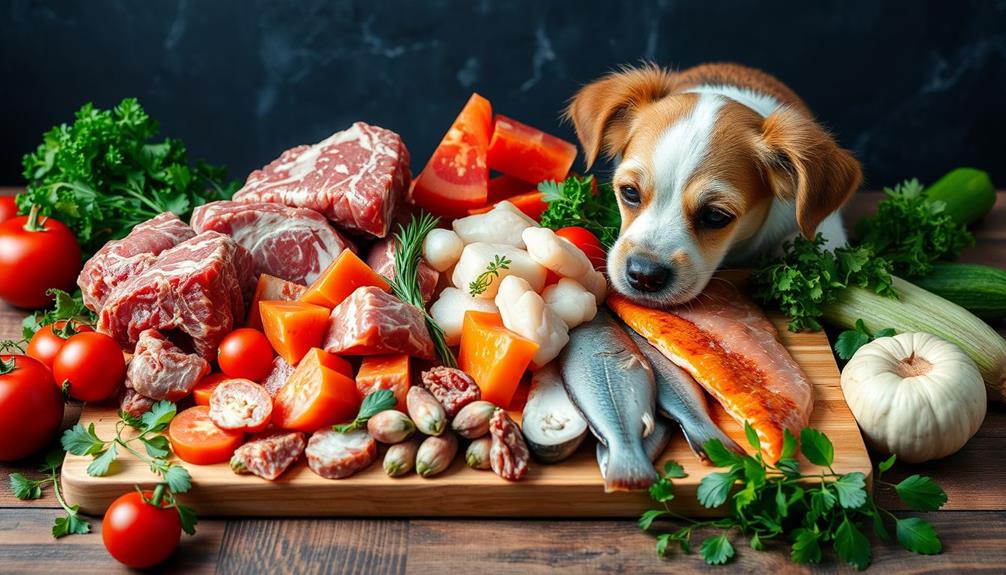
Exploring different proteins is a vital step in getting your dog to embrace raw food. Dogs can be picky eaters, especially when it comes to unfamiliar foods. By offering a variety of proteins, you help them discover their preferences. You might find that proteins like chicken and beef can be easily integrated into their meals, similar to how one might prepare Easy Homemade Flautas with different fillings to cater to taste.
Here are three options to take into account:
- Chicken – A common protein that many dogs enjoy. It's also easy to find in most dog food brands.
- Beef – Rich in iron and other nutrients, beef can be a tasty choice that appeals to your dog's palate.
- Lamb – A less common protein that might intrigue your dog and offer a new flavor experience.
Start by introducing new proteins gradually alongside those they're already familiar with. This approach builds trust and encourages exploration.
If your dog initially rejects raw food, don't be discouraged; persistence is essential. Rotate proteins like venison, turkey, and duck to keep meals exciting and prevent boredom.
We Feed Raw provides excellent variety with six different protein choices, making it easier to explore different proteins. Keep observing your dog's reactions, and customize their diet for best enjoyment and nutrition.
Create a Positive Feeding Environment
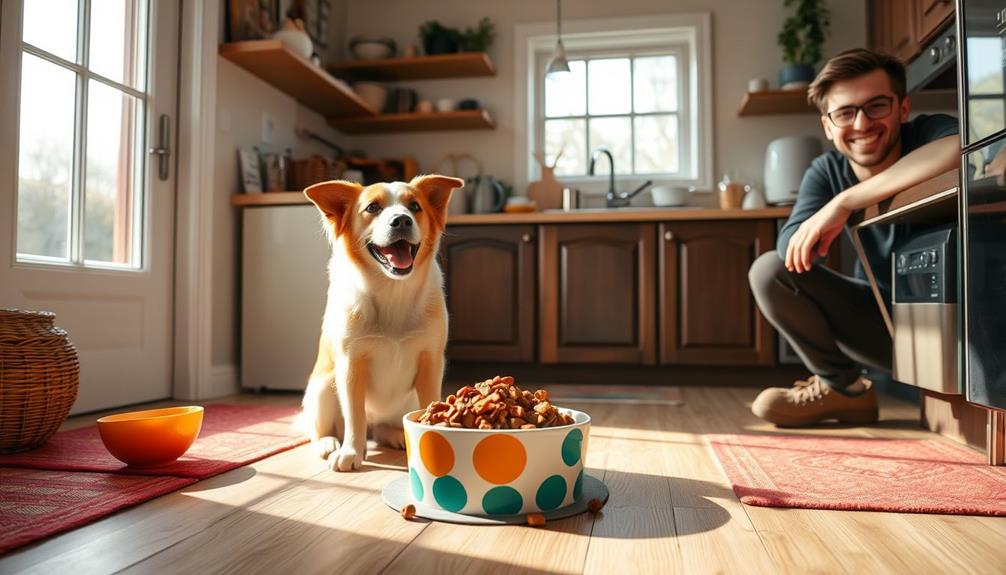
To encourage your dog to eat raw food, start by creating a calm feeding atmosphere.
Incorporating a personal budget for pet food can help guarantee you're providing high-quality ingredients without overspending.
Limit distractions and stick to a consistent mealtime routine, so your furry friend knows when to expect their meals.
This approach not only reduces anxiety but also helps your dog associate mealtime with comfort and security.
Calm Feeding Atmosphere
Creating a calm feeding atmosphere is vital for encouraging your dog to embrace a raw food diet. Dogs thrive in serene settings, much like their wild counterparts. When you provide a peaceful environment, you help promote healthier feeding habits and a positive feeding experience.
Additionally, understanding your dog's needs, similar to how caregivers assess the importance of long-term planning for elderly care, can enhance their comfort during feeding times.
Here are three strategies to create that calm environment:
- Choose a Quiet Location: Designate a specific area away from distractions, like loud noises or foot traffic. This could be a cozy corner or even a crate, where your dog can feel secure.
- Limit Feeding Time: Only leave food out for a short period. This encourages your dog to eat promptly and reinforces a stress-free routine without overwhelming them with leftovers.
- Minimize Interruptions: Guarantee feeding times are free from disturbances. Turn off the TV, close doors, and keep the atmosphere relaxed to help your dog feel more at ease.
Consistent Mealtime Routine
Establishing a consistent mealtime routine not only helps your dog feel secure but also signals when it's time to eat, promoting regular feeding habits. By serving meals at the same time each day, you reinforce a feeding schedule that reduces anxiety around mealtime. This predictability makes it easier for your dog to anticipate their raw food, encouraging them to eat more willingly.
Creating a calm and quiet feeding environment is essential. Minimize distractions during mealtime so your dog can focus on their food. A peaceful atmosphere allows them to feel more comfortable and confident while eating.
It's also important to avoid excessive attention or interaction during these moments. This approach fosters independent eating habits, which can reduce any pressure that might deter them from enjoying their meals.
Consistency in offering raw food at regular intervals teaches your dog to recognize it as a staple part of their diet. Over time, this routine promotes acceptance and encourages your dog to embrace their raw food meals.
Use Consistent Feeding Practices
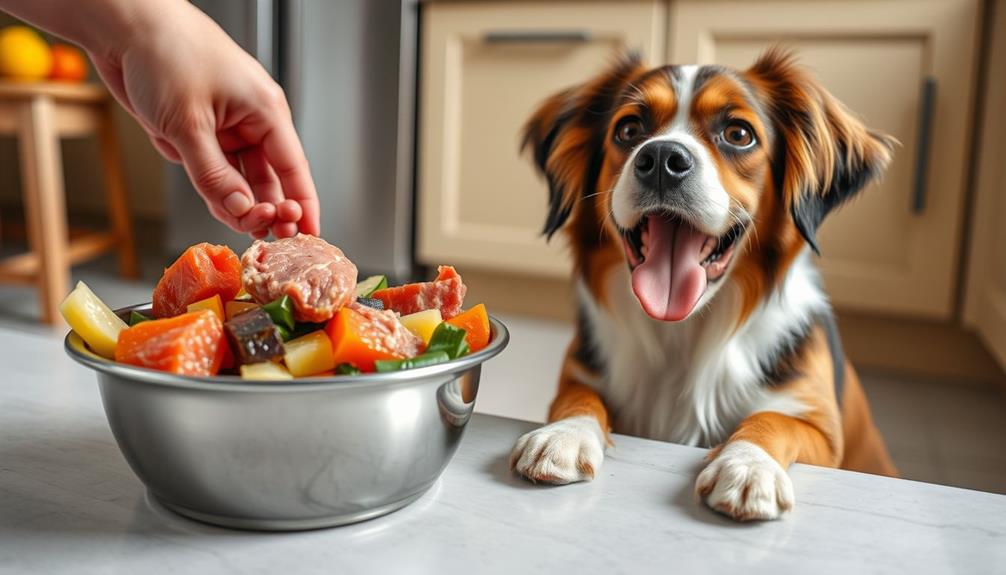
A consistent feeding schedule is essential for getting your dog to embrace raw food. By establishing a regular routine, your dog will feel more comfortable and willing to eat during designated mealtimes.
Here's how to create an effective feeding routine:
- Set specific meal times: Feed your dog at the same times each day to reinforce predictability.
- Walk away after serving: Once you've offered the raw food, step away for about 20 minutes. This allows your dog to approach the food at their own pace without feeling pressured.
- Remove uneaten food: If your dog doesn't eat, calmly take the food away without any emotional response. This teaches them that food isn't available indefinitely, encouraging them to eat when offered.
Manage Meal Refusal
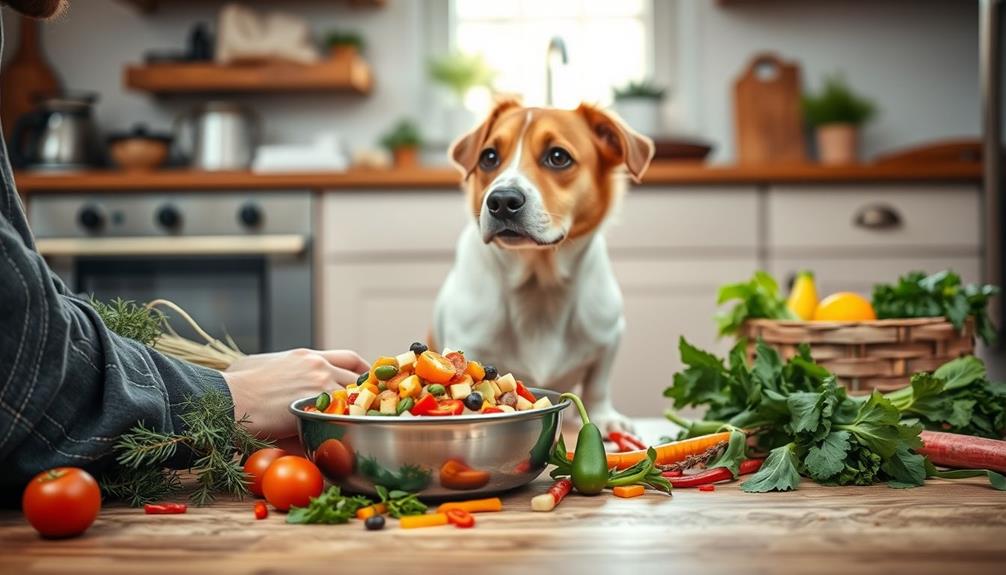
Meal refusal can be frustrating, but it's important to remember that most dogs won't starve themselves and will eventually eat when they're hungry. If your dog skips a meal, don't panic. Occasional meal refusal can be beneficial for their digestive health, especially for adult dogs with fluctuating appetites.
However, it's essential to observe any underlying issues that might affect your dog's appetite, like stress or environmental changes. Managing meal refusal involves maintaining a neutral demeanor during mealtime. Avoid putting excessive pressure on your dog to eat, as this can reinforce picky eating habits. Instead, let them decide when they're ready to eat.
You can also encourage your dog to try raw food by gradually introducing it alongside their current diet. This approach helps them adjust without feeling overwhelmed. One way to do this is by mixing in small amounts of raw food with their regular meals and gradually increasing the proportion of raw food over time. Additionally, you can use positive reinforcement and praise to encourage your dog to try the new food. When introducing raw food to puppy, it’s important to monitor their digestion and overall well-being to ensure they are adjusting well to the change in diet. Remember to consult with a veterinarian before making any significant changes to your dog’s diet.
Be persistent with your encouragement, and over time, your dog will likely learn to enjoy raw food. Remember that creating a calm and pressure-free environment during mealtimes can greatly impact their willingness to eat.
With patience and consistency, your dog will develop a healthy appetite for their new diet.
Encourage Exploration and Play
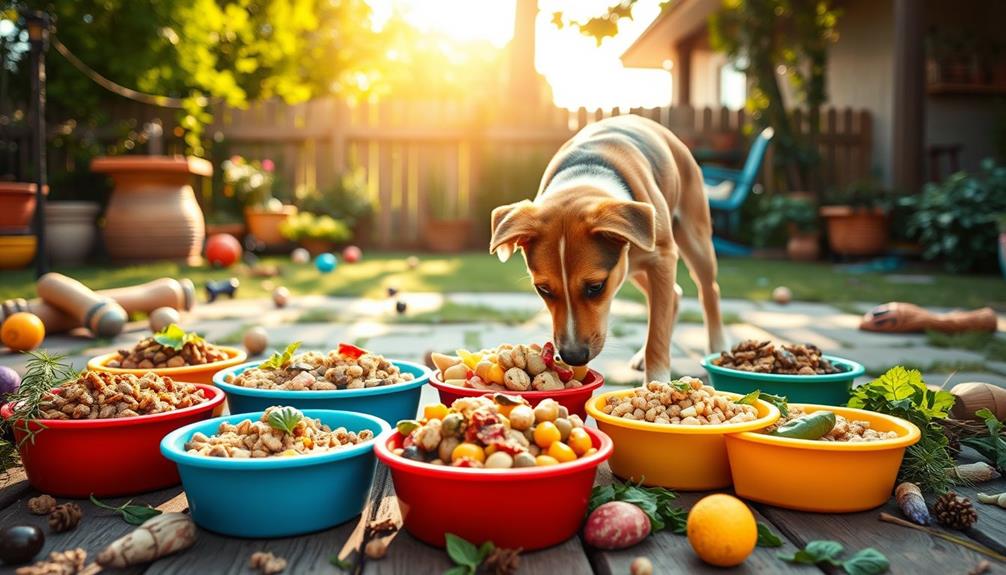
Encouraging your dog to explore and play with their food can transform mealtime into an exciting adventure. By incorporating fun elements into their feeding routine, you can stimulate their minds while making raw food more appealing.
Here are three effective strategies:
- Interactive Toys: Stuff raw food into Kongs or other interactive toys. This not only makes mealtime a challenge but also encourages your dog to engage with their food, promoting exploration.
- Food Puzzles: Use food puzzles that dispense raw food as your dog interacts with them. These toys reward your dog's efforts and keep them entertained, turning feeding into a rewarding game.
- Scavenger Hunts: Hide small pieces of frozen raw food around your home or yard. This mimics their natural scavenging instincts and adds an element of play, increasing their curiosity about their meals.
You can even rotate the serving method by occasionally spoon-feeding raw food, creating a novel experience that entices your dog.
Monitor Health During Transition
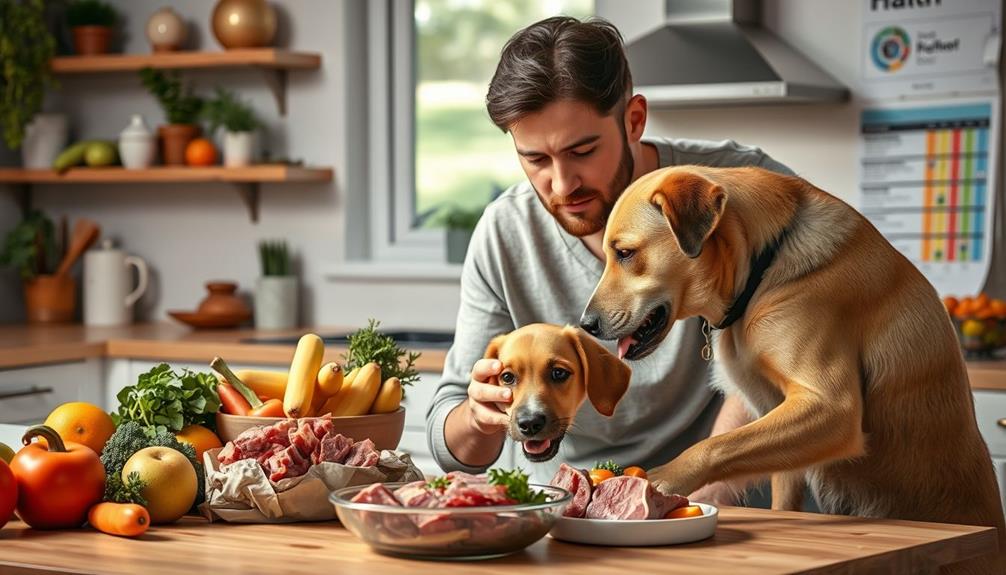
During the change to a raw food diet, it's vital to keep a close eye on your dog's health. Monitoring for detox symptoms such as vomiting or loose stools is important, as these can last anywhere from days to months.
If you notice any digestive issues, consider adding plain canned pumpkin to help firm up stools. Probiotics can also support your dog's digestive health during this adjustment period.
Observe changes in your dog's digestion and hydration closely. Raw diets can enhance nutrient absorption, which may decrease stool frequency. However, it's necessary to provide fresh, clean water at all times, as the moisture content in raw food can affect their overall water intake.
Regular vet check-ups are highly recommended throughout this change. Your veterinarian can help you monitor your dog's health and make necessary adjustments based on their individual responses.
Keeping track of your pet's well-being during this period will help guarantee a successful change to a raw food diet, allowing them to thrive on this new nutrition plan.
Seek Support and Resources
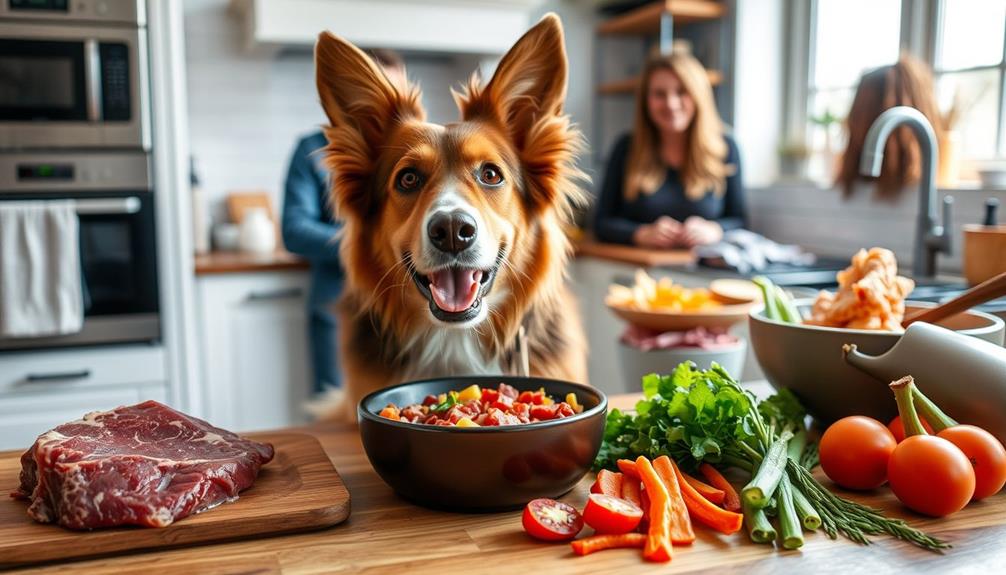
As you monitor your dog's health through this dietary change, seeking support and resources can make the journey smoother. Connecting with the right people and materials guarantees you have the guidance you need.
Here are three key resources to take into account:
- Online Communities: Engage with forums and social media groups dedicated to raw feeding. Experienced pet owners share invaluable insights and tips that can ease your shift.
- Educational Materials: Look for books, guides, and videos that provide thorough information on raw diets. These resources can help you understand the nutritional needs of your dog and how to implement changes effectively.
- Holistic Veterinarians: Consulting with holistic vets can tailor a raw feeding plan specific to your dog's breed, age, and health status. Their expertise will guarantee your dog receives ideal nutrition.
Additionally, think about subscription services for raw dog food, which simplify meal planning and provide consistent access to quality meals.
Don't hesitate to reach out for personalized assistance via email or social media to tackle specific feeding challenges.
With the right support and resources, you'll help your dog thrive on a raw food diet.
Frequently Asked Questions
How Can I Encourage My Dog to Eat Raw Food?
To encourage your dog to eat raw food, try searing the meat lightly, mixing in warm water or broth, and offering different protein sources. Establish a routine and use interactive toys to make mealtime engaging.
How Do I Transition My Dog to a Raw Food Diet?
Shifting your dog to raw food requires patience and strategy. Start with a mix of kibble and raw, gradually increasing the raw portion. Monitor their response, and remember, each dog adjusts at their own pace.
How to Properly Feed Your Dog Raw Food?
To properly feed your dog raw food, start with a balanced diet, serve meals at room temperature, create a consistent feeding schedule, and monitor your dog's health to confirm they're adapting well to the new food.
How Long Does It Take for a Dog to Get Used to a Raw Diet?
It usually takes about 10 days for your dog to adjust to a raw diet. Start gradually mixing kibble and raw food, monitoring their response, and be patient as they adapt to this new nutrition.
Conclusion
Changing your dog to a raw food diet can be a rewarding journey for both of you. Did you know that over 70% of dog owners report improved energy levels and coat condition after switching to raw food? By understanding the benefits, gradually introducing new proteins, and creating a positive feeding experience, you can help your furry friend thrive. Don't hesitate to seek support and monitor their health along the way for the best results!
